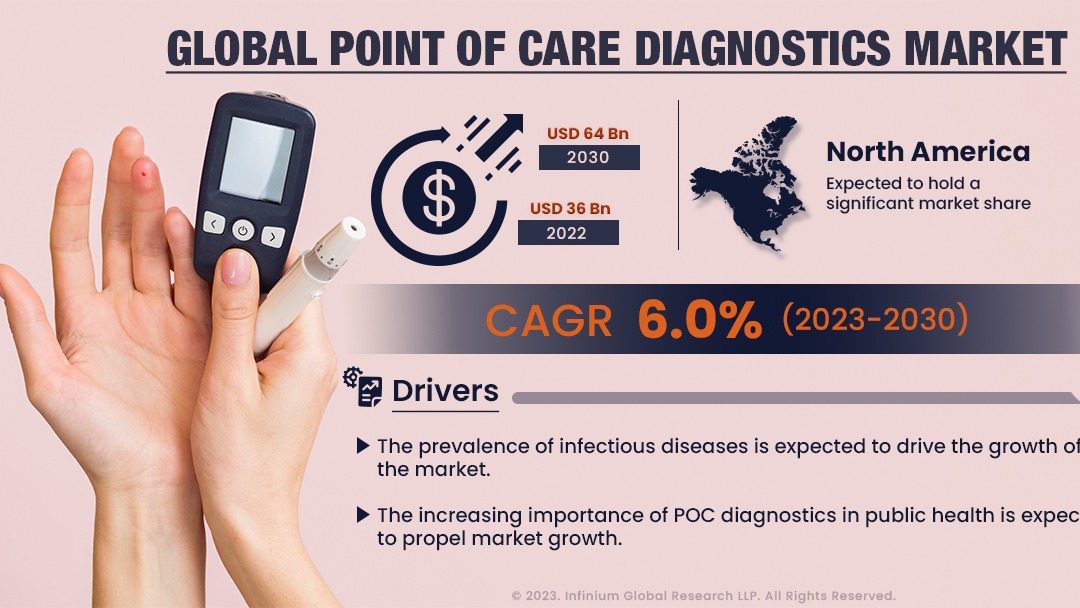Point of Care Diagnostics Market (Application - Glucose, HIV, Hepatitis, Influenza, and Others; Sample - Blood, and Urine; End User - Pharmacy, Hospital, Homecare, and Others): Global Industry Analysis, Trends, Size, Share and Forecasts to 2030
A recent report published by Infinium Global Research on point of care diagnostics market provides in-depth analysis of segments and sub-segments in the global as well as regional point of care diagnostics market. The study also highlights the impact of drivers, restraints, and macro indicators on the global and regional point of care diagnostics market over the short term as well as long term. The report is a comprehensive presentation of trends, forecast and dollar values of global point of care diagnostics market.
Market Insight:
Point of care testing refers to diagnostic medical testing that can be performed near the patient, outside of the traditional laboratory setting. Such testing devices used for monitoring glucose, ECG, and blood pressure have greatly improved clinical and personalized healthcare. Advancements in microfluidics, paper-based diagnostics, and biosensing technology have led to the development of cutting-edge POC diagnostic tools that are effective and of high quality. Moreover, emerging technologies such as Artificial Intelligence and the Internet of Things are being integrated into next-generation POC diagnostic tools, a development being driven by scientists and entrepreneurs. POC technologies, along with intelligent information and communications technology, can greatly enhance healthcare services in rural areas and help manage resources sustainably. The global market for POC diagnostic devices is poised to grow rapidly in the coming years, owing to increasing investments in research and development, and the rising demand for cost-effective and efficient healthcare solutions.
The point of care diagnostics market is expected to witness significant growth due to the increasing prevalence of infectious diseases, technological advancements, and the need for fast results. Factors such as an aging population, lifestyle diseases, and the incidence of infectious diseases are driving the demand for point of care diagnostics. The importance of POC diagnostics in public health is also increasing, which is expected to drive market growth. Faster test results are preferred by patients and doctors, making POC diagnostics a practical and simple method. However, accuracy concerns associated with rapid point-of-care diagnostic tests are hindering market growth. Opportunities for growth in the market include technological innovations in healthcare, a focus on product innovation, and the development of efficient POC diagnostic kits for patients. Additionally, the growth of healthcare infrastructure will create further opportunities for market growth.

The global market for point of care diagnostics is divided into North America, Europe, Asia Pacific, and Row based on geography. North America is expected to hold a considerable share in the market, owing to the high prevalence of diseases in the region and favorable government policies and initiatives towards healthcare infrastructure development. The region also has high awareness levels among patients and healthcare providers regarding early disease detection, which supports its dominance in the market. The Asia Pacific region is expected to be the most promising market, with high medical requirements and continuously improving healthcare infrastructure, rising healthcare awareness, and increasing per capita income levels in developing economies such as China and India. As the region with the highest population, Asia Pacific will lead to significant growth in the future. The European region also has a significant demand for point of care diagnostics due to increasing awareness among the general population.
Report Scope of the Point of Care Diagnostics Market:
| Report Coverage | Details |
|---|---|
| Market Size in 2022 | Above USD 36 Billion |
| Market Size by 2030 | More than USD 64 Billion |
| Growth Rate from 2023 to 2030 | CAGR of Over 6% |
| Largest Market | North America |
| No. of Pages | 255 |
| Market Drivers |
|
| Market Segmentation | By Application, By Sample, and By End User |
| Regional Scope | North America, Europe, Asia Pacific, and RoW |
Segment wise revenue contribution in the global point of care diagnostics market
The report on global point of care diagnostics market provides a detailed analysis of segments in the market based on Application, Sample, and End User.
Segmentation Based on Application
· Glucose
· HIV
· Hepatitis
· Influenza
· Others
Segmentation Based on Sample
· Blood
· Urine
Segmentation Based on End User
· Pharmacy
· Hospital
· Homecare
· Others
Company Profiled:
· Abbott
· Trinity Biotech plc
· Quidel Corporation
· BD
· Chembio Diagnostics, Inc.
· EKF Diagnostics Holdings
· SEKISUI Diagnostics
· Thermo Fisher Scientific Inc.
· Danaher
· Siemens Healthcare GmbH
Report Highlights:
The report provides deep insights into demand forecasts, market trends, and micro and macro indicators. In addition, this report provides insights into the factors that are driving and restraining the growth in this market. Moreover, The IGR-Growth Matrix analysis given in the report brings an insight into the investment areas that existing or new market players can consider. The report provides insights into the market using analytical tools such as Porter's five forces analysis and DRO analysis of the point of care diagnostics market. Moreover, the study highlights current market trends and provides forecasts from 2023-2030. We also have highlighted future trends in the market that will affect the demand during the forecast period. Moreover, the competitive analysis given in each regional market brings an insight into the market share of the leading players.
